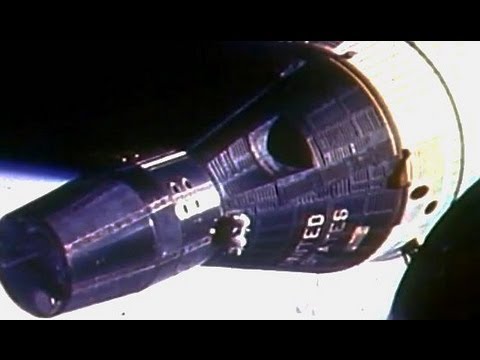Gemini 7 & Gemini 6: “Proud Conquest” 1966 NASA ( Gemini VI – Gemini VII )
more at
“Astronauts Borman, Lovell, Schirra and Stafford tell about the first rendezvous of two manned spacecraft. The unprecedented pad turnaround at Cape Kennedy and President Johnson’s press conference following the event are included.”
NEW VERSION with improved video & sound:
Reupload of a previously uploaded film with improved sound and video, and all in one piece instead of parts.
Public domain film from NASA, slightly cropped to remove uneven edges, with the aspect ratio corrected, and 1-pass exposure & color correction applied (cannot be ideal in all scenes).
The soundtrack was also processed with volume normalization, noise reduction, clipping reduction, and/or equalization (the resulting sound, though not perfect, is far less noisy than the original).
Gemini 7 (officially Gemini VII) was a 1965 manned spaceflight in NASA’s Gemini program. It was the 4th manned Gemini flight, the 12th manned American flight and the 20th spaceflight of all time (includes X-15 flights over 100 kilometers (330,000 ft)). The crew of Frank F. Borman, II and James A. Lovell, Jr spent nearly 14 days in space making a total of 206 orbits, and were joined on orbit by the Gemini-6A flight which performed the first rendezvous maneuver of manned spacecraft.
Objectives
Gemini 7 was originally intended to fly after Gemini 6, but the original Gemini 6 mission was cancelled after the failure during launch of the Agena Target Vehicle with which it was meant to rendezvous and dock. The objective of rendezvous was so important, that it was decided to fly Gemini 6 at the same time as Gemini 7, using the latter as the rendezvous target…
This 14 day mission required NASA to solve problems of long-duration space flight… The astronauts also evaluated a new lightweight spacesuit, which proved uncomfortable if worn for a long time in Gemini’s hot, cramped quarters. The high point of the mission was the rendezvous with Gemini VI. But the three days that followed were something of an endurance test, and both astronauts, heeding Pete Conrad’s Gemini V advice, brought books along. Gemini VII was the longest space flight in U.S. history until the Skylab missions of the 1970s.
Flight
The launch and ascent were nominal…
They spent the rest of their first day in space doing some experiments and eating their first meal… For the first time during a flight, one of the crew was allowed to take off his suit. Borman and Lovell had planned to both take them off two days into the mission when they were satisfied that the environmental system was working properly. The NASA managers did not like this idea and said that at least one crew member had to be wearing a suit at all times. Borman was wearing his suit and was sweating profusely, but agreed to let Lovell stay out his suit as Lovell was the larger of the two and it required a lot of effort to get in and out of a suit in little more space than the front seat of a car.
Later the flight controllers ordered Lovell to don his suit and Borman to get out of his. This was because the doctors wanted to see the effects of being suited and unsuited on the crewmembers. So 148 hours into the flight, Borman got his chance to cool down. Finally the NASA managers decided that there was little benefit in having the crew members suited and so relented after a couple of days…
Rendezvous
Gemini 6A launched December 15…
The plan called for the rendezvous to take place on the fourth orbit of Gemini 6A…
The radar on Gemini 6A first made contact with Gemini 7 at 3 hours and 15 minutes when they were 234 nautical miles (433 km) away. A third burn put them into a 146-by-148-nautical-mile (270 by 274 km) orbit. As they slowly gained, Walter Schirra put Gemini 6A’s computer in charge of the rendezvous, and at 5 hours and 4 minutes, he saw a bright object that he at first thought was the star Sirius, but was in fact Gemini 7.
After several more burns the two spacecraft were only 130 feet (40 m) apart. The burns had only used 110 pounds (50 kg) of fuel on Gemini 6A, leaving plenty of fuel. During the next 270 minutes the crews moved as close as 1 foot (30 cm), talking over the radio…
Gemini 6A reentered the next day, landing within 9.7 nautical miles (18.0 km) of the planned site, the first truly accurate atmospheric reentry…
By this time the novelty of spaceflight had worn off for the crew of Gemini 7. They had spent 11 days in space and had three more to go… Finally the last day of the mission arrived and the crew stored everything for re-entry. The retro-rockets worked perfectly after 14 days in space. They landed within 6.4 nautical miles (11.9 km) of the targeted landing point.

